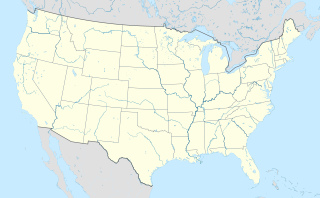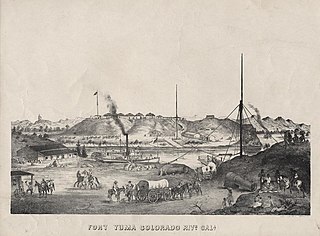
Manzanar is most widely known as the site of one of ten American concentration camps where over 110,000 Japanese Americans were incarcerated during World War II from December 1942 to 1945. Located at the foot of the Sierra Nevada in California's Owens Valley between the towns of Lone Pine to the south and Independence to the north, it is approximately 230 miles (370 km) north of Los Angeles. Manzanar was identified by the United States National Park Service as the best-preserved of the former camp sites, and is now the Manzanar National Historic Site, which preserves and interprets the legacy of Japanese American incarceration in the United States.

Calaveras County, officially the County of Calaveras, is a county in the northern portion of the U.S. state, California. As of the 2010 census, the population was 40,171. The county seat is San Andreas. Angels Camp is the only incorporated city in the county. Calaveras is the Spanish word for skulls; the county was reportedly named for the remains of Native Americans discovered by the Spanish explorer Captain Gabriel Moraga.

Angels Camp, also known as City of Angels and formerly Angel's Camp, Angels, Angels City, Carson's Creek and Clearlake, is the only incorporated city in Calaveras County, California, United States. The population was 3,835 at the 2010 census, up from 3,004 at the 2000 census. It lies at an elevation of 1378 feet.

Weedpatch is an unincorporated community and census-designated place (CDP) in Kern County, California, United States. Weedpatch is 10 miles (16 km) south-southeast of Bakersfield. It is considered to be one of the poorest areas in Kern County. As of the 2010 census it had a population of 2,658.

Union is a town located in the northeastern part of Tolland County, Connecticut, United States and is part of the Quinebaug and Shetucket Rivers Valley National Heritage Corridor. The population was 854 at the 2010 census, making it the least populous town and municipality in Connecticut. Union includes the village of Mashapaug located in the Eastern Uplands at the Massachusetts state line. Also, Union is located 33 miles northeast of the state capital, Hartford and 67 mi (108 km) southwest of Boston as well as 153 mi (246 km) northeast of New York City.

The Drum Barracks, also known as Camp Drum and the Drum Barracks Civil War Museum, is the last remaining original American Civil War era military facility in the Los Angeles area. Located in the Wilmington section of Los Angeles, near the Port of Los Angeles, it has been designated as a California Historic Landmark, a Los Angeles Historic Cultural Monument and has been listed on the National Register of Historic Places. Since 1987, it has been operated as a Civil War museum that is open to the public.

Philip St. George Cooke was a career United States Army cavalry officer who served as a Union General in the American Civil War. He is noted for his authorship of an Army cavalry manual, and is sometimes called the "Father of the U.S. Cavalry." His service in the Civil War was significant, but was eclipsed in prominence by the contributions made by his famous son in law, J.E.B. Stuart, to the Confederate States Army.

California's involvement in the American Civil War included sending gold east, recruiting volunteer combat units to replace regular forces in territories of the Western United States, maintaining and building numerous camps and fortifications, suppressing secessionist activity and securing the New Mexico Territory against the Confederacy. The State of California did not send its units east, but many citizens traveled east and joined the Union Army there, some of whom became famous. California's Volunteers also conducted many operations against the native peoples within the state and in the other Western territories of the Departments of the Pacific and New Mexico.
The Pacific Coast Theater of the American Civil War consists of major military operations in the United States on the Pacific Ocean and in the states and Territories west of the Continental Divide. The theater was encompassed by the Department of the Pacific that included the states of California, Oregon, and Nevada, the territories of Washington, Utah, and later Idaho.

Fort Yuma was a fort in California located in Imperial County, across the Colorado River from Yuma, Arizona. It was on the Butterfield Overland Mail route from 1858 until 1861 and was abandoned May 16, 1883, and transferred to the Department of the Interior. The Fort Yuma Indian School and the Saint Thomas Yuma Indian Mission now occupy the site. It is one of the "associated sites" listed as Yuma Crossing and Associated Sites on the National Register of Historic Places in the Yuma Crossing National Heritage Area. In addition, it is registered as California Historical Landmark #806.

Pulga is an unincorporated community in Butte County, California. It is located along the west slope of the Feather River canyon, at an elevation of 1398 feet. A variant name for the community is Big Bar. Other nearby communities include Mayaro, Poe and Parkhill. The town hosts a Caltrans highway maintenance station along State Route 70 (SR70). The place is at the mouth of the Flea Valley Creek, which gives rise to the toponym.

Ophir is an unincorporated community in Placer County, California.

The San Francisco Bay Area Council (SFBAC) is a council of the Boy Scouts of America, formed by a merger of the San Francisco Area and Oakland Area Councils in February 1964. Located in the San Francisco Bay Area, serving the cities of Colma, Daly City, San Francisco, Emeryville, Oakland, San Leandro, Hayward, Fremont, Union City, Newark, Pleasanton, Dublin, and Livermore, as well as unincorporated communities such as Castro Valley, San Lorenzo, and Sunol.

Nevada's entry into statehood in the United States on October 31, 1864, in the midst of the American Civil War, was expedited by Union sympathizers in order to ensure the state's participation in the 1864 presidential election in support of President Abraham Lincoln. Thus Nevada became one of only two states admitted to the Union during the war and earned the nickname that appears on the Nevada state flag today: "Battle Born".

The history of Idaho in the American Civil War is atypical, as the territory was far from the battlefields.

Sutterville is a former settlement in Sacramento County, California. It was located on the Southern Pacific Railroad 2.25 miles (3.6 km) south-southwest of Sacramento,
Union Flat is a former settlement and mining camp in El Dorado County, California. It was located 0.5 miles (0.8 km) north of Spanish Flat.
Lippitt or Camp Lippitt is a former settlement and military post in Humboldt County, California. It was located near the settlement of Bucksport. Camp Lippet was named for Col. Francis J. Lippitt of the 2nd California Infantry and was in use for two months, in 1862. It was established to help alleviate the inadequacies at Fort Humboldt and consisted entirely of rented buildings in Bucksport, garrisoned by Company F, 2nd Regiment California Volunteer Infantry.
Palm City is a neighborhood in the southern section of San Diego. It neighbors Otay Mesa West to the south and east, Egger Highlands and Nestor to the west, and Chula Vista to the north. It also serves as a gateway to the beach cities of Imperial Beach, and Coronado, by way of the Silver Strand isthmus, due to it being where California State Route 75 meets Interstate 5. Major thoroughfares include Coronado Avenue, Hollister Street, Beyer Boulevard, and Palm Avenue.

Coleman City, also called Emily City, is a ghost town in San Diego County, California. It lies at an elevation of 3601 feet. It is located on State Highway 78 where it crosses Coleman Creek, about four miles west of Julian.
















